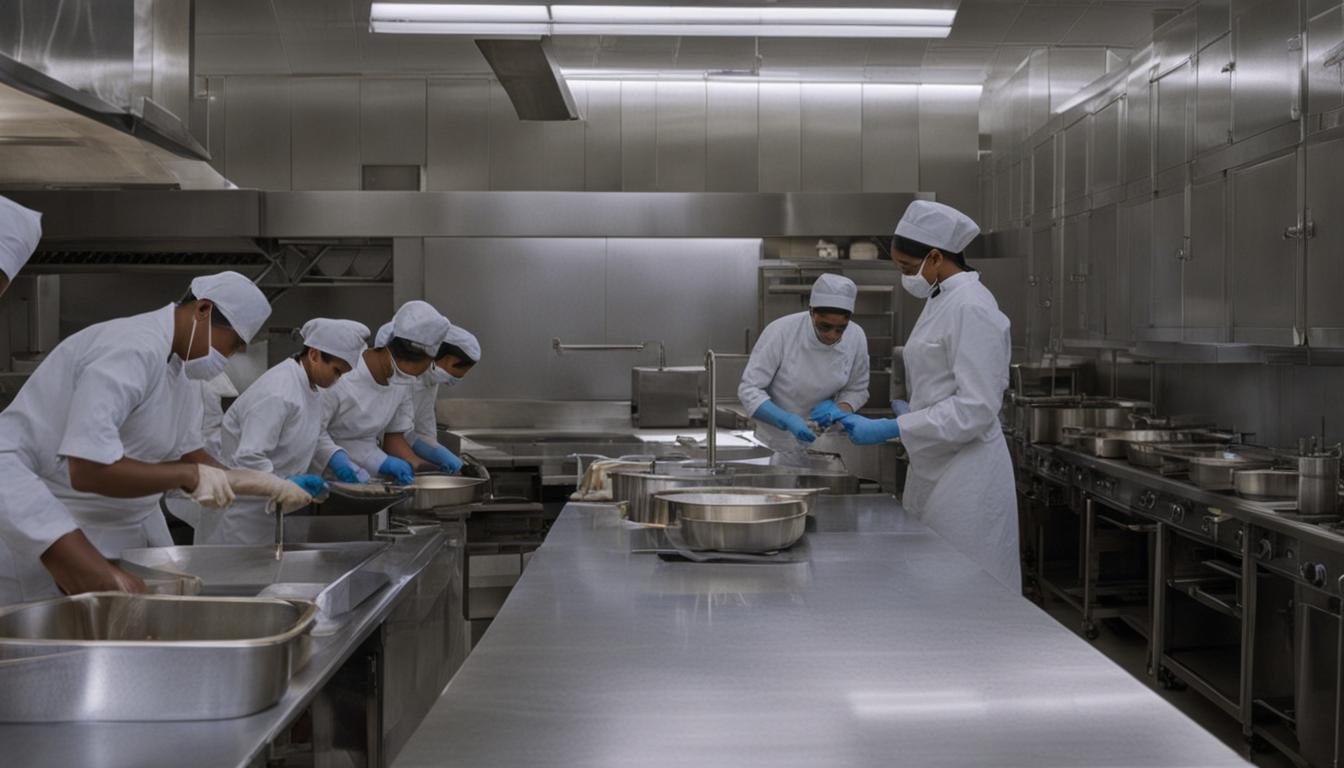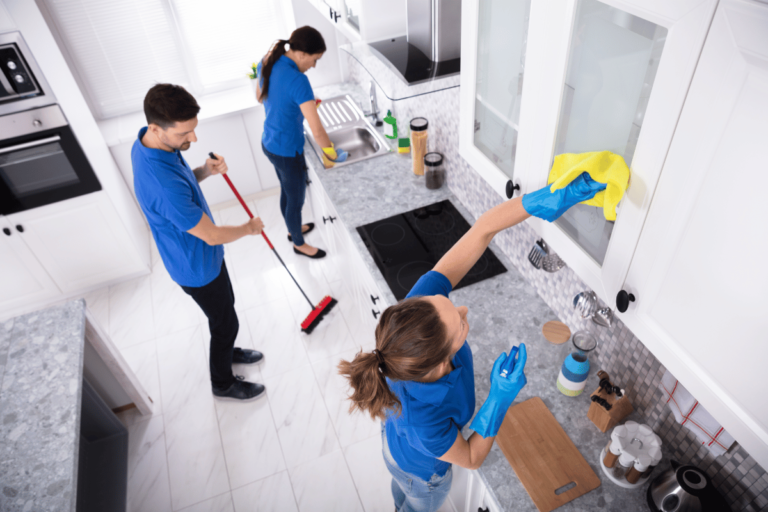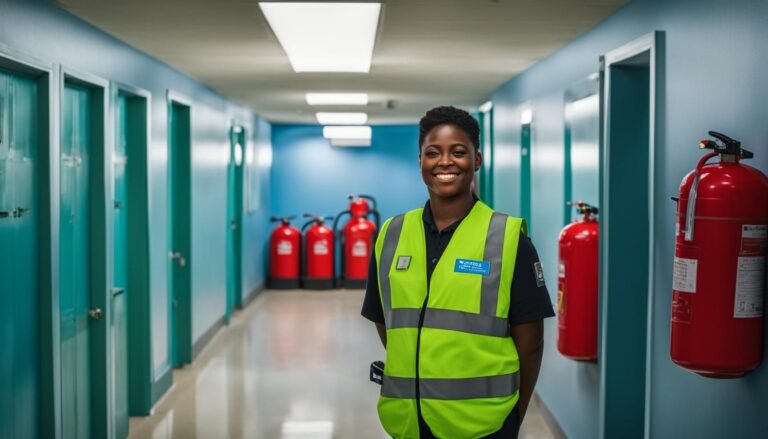Mastering Adhering to Food Safety Standards in Hotel Kitchens
Welcome to our article on mastering the art of adhering to food safety standards in hotel kitchens. In this piece, we will explore the importance of food safety, the regulations that hotels must comply with, and the best practices to ensure a safe and hygienic kitchen environment. So, whether you’re a seasoned chef or a hotel manager, read on to discover how you can maintain impeccable food safety in your hotel kitchen.
Key Takeaways:
- Adhering to food safety standards is crucial to protect the health of guests and maintain a good reputation in hotel kitchens.
- Hotel kitchens must comply with food safety regulations and guidelines set by local health authorities.
- Implementing best practices, such as proper handwashing, surface cleaning, and temperature control, is essential for food safety in hotel kitchens.
- Certified food handlers play a vital role in upholding food safety standards and ensuring safe food preparation and service.
- Management should prioritize food safety, provide training and education to staff, and utilize technology to enhance compliance efforts.
Importance of Food Safety in Hotel Kitchens
Ensuring food safety is of utmost importance in hotel kitchens. The implementation of kitchen hygiene standards and adherence to food safety protocols are essential to protect the health of guests and maintain a good reputation. By following these practices, hotel kitchens can prevent cross-contamination, food spoilage, and the spread of foodborne illnesses.
Proper food handling and storage are crucial in maintaining food safety. Hotel kitchens must handle raw and cooked foods separately to avoid contamination. Additionally, maintaining correct storage temperatures and ensuring proper cooking temperatures are vital in preventing the growth of harmful bacteria. By prioritizing food safety, hotel kitchens can provide guests with a safe and enjoyable dining experience.
It is important to note that following food safety protocols goes beyond protecting the health of guests. It also safeguards the reputation and success of the hotel. A single instance of food poisoning or a violation of food safety regulations can result in negative reviews and loss of customer trust. By prioritizing food safety in hotel kitchens, establishments can maintain a high standard of quality and build customer loyalty.
Understanding Food Safety Regulations
Hotel kitchens are required to comply with a variety of food safety regulations to ensure the proper handling and preparation of food. These regulations are put in place by local health authorities to protect the health and safety of guests and prevent foodborne illnesses. It is essential for hotel kitchens to have a thorough understanding of these regulations and follow them diligently to maintain a high level of food safety.
Food safety regulations encompass various aspects of kitchen operations, including proper food storage, temperature control, equipment sanitation, and staff hygiene. Each of these areas plays a critical role in preventing foodborne illnesses and ensuring the safety of guests. Failure to comply with these regulations can lead to fines, penalties, or even the closure of the kitchen.
By maintaining awareness of food safety regulations and implementing the necessary measures, hotels can create a safe and hygienic environment for food preparation. Regular inspections by health authorities help to ensure compliance with these regulations, providing an extra layer of assurance for guests. It is the responsibility of hotel management and staff to stay informed about any updates or changes to food safety regulations and make the necessary adjustments to their practices.
Table: Key Food Safety Regulations in Hotel Kitchens
| Regulation | Description |
|---|---|
| Proper Food Storage | Guidelines for storing food at the correct temperatures and preventing cross-contamination. |
| Temperature Control | Requirements for monitoring and maintaining safe temperatures during food preparation, cooking, and storage. |
| Equipment Sanitation | Procedures for cleaning and sanitizing kitchen equipment to prevent the growth of harmful bacteria. |
| Staff Hygiene | Rules regarding personal hygiene practices, including handwashing, proper clothing, and illness reporting. |
By strictly adhering to food safety regulations, hotel kitchens can ensure that guests are served safe and hygienic meals. This not only protects the health and well-being of guests but also helps to build a reputation for excellence and professionalism within the hospitality industry.
Best Practices for Food Safety in Hotel Kitchens
When it comes to ensuring food safety in hotel kitchens, following best practices is essential. By implementing these practices, kitchen staff can minimize the risk of foodborne illnesses and maintain a safe working environment. Let’s explore some of the key best practices for food safety in hotel kitchens:
Proper Handwashing Techniques
- Handwashing is one of the most important steps in preventing the spread of bacteria and viruses in the kitchen.
- Staff should wash their hands thoroughly with soap and warm water for at least 20 seconds before and after handling food, after using the restroom, and after touching any potentially contaminated surfaces.
- Using hand sanitizers with at least 60% alcohol content can also be an effective alternative when handwashing facilities are not readily available.
Cleaning and Sanitizing Kitchen Surfaces
- Regular cleaning and sanitizing of kitchen surfaces, including countertops, cutting boards, utensils, and equipment, is crucial for preventing cross-contamination.
- All surfaces should be cleaned with hot, soapy water and then sanitized with an appropriate sanitizer, following the manufacturer’s instructions.
- It’s important to pay extra attention to high-touch areas and surfaces that come into direct contact with food.
Separating Raw and Cooked Foods
- Keeping raw and cooked foods separate is essential to prevent cross-contamination and the spread of foodborne pathogens.
- Use separate cutting boards, utensils, and containers for raw and cooked foods.
- Store raw meats, poultry, and seafood on the bottom shelf of the refrigerator to prevent any drips or leaks from contaminating other foods.
Maintaining Correct Storage and Cooking Temperatures
- Proper storage and cooking temperatures are crucial for preventing the growth of bacteria that can cause foodborne illnesses.
- Refrigerators should be set at a temperature of 40°F (4°C) or below, while freezers should be set at 0°F (-18°C) or below.
- Cooked foods should be reheated to a minimum internal temperature of 165°F (74°C) to ensure they are safe to eat.
By following these best practices, hotel kitchens can maintain a high level of food safety and provide guests with a safe dining experience. Implementing proper handwashing techniques, regularly cleaning and sanitizing kitchen surfaces, separating raw and cooked foods, and maintaining correct storage and cooking temperatures are essential steps in preventing foodborne illnesses and ensuring the overall safety of the kitchen environment.
Importance of Certified Food Handlers
One of the key components of maintaining food safety in hotel kitchens is the presence of certified food handlers. These individuals play a vital role in upholding and implementing proper food handling, sanitation, and hygiene practices in the kitchen. By obtaining certification, they acquire a deep understanding of the best practices and protocols required to prevent foodborne illnesses and maintain a safe working environment for both staff and guests.
When it comes to food safety, certified food handlers are responsible for a range of crucial tasks. They ensure that proper food storage and handling techniques are followed, preventing cross-contamination and maintaining the quality and integrity of ingredients. They also play a significant role in monitoring and maintaining cleanliness in the kitchen, ensuring that all surfaces, utensils, and equipment are properly sanitized. By doing so, they minimize the risk of foodborne illnesses and create a safe environment for food preparation and service.
Having certified food handlers in hotel kitchens not only helps in adhering to food safety standards but also reflects the commitment of the establishment towards providing a safe dining experience. These individuals undergo comprehensive training that covers topics such as personal hygiene, safe food handling practices, allergen management, and proper cleaning and sanitizing techniques. Their knowledge and expertise enable them to detect potential hazards, implement corrective measures, and take proactive steps to prevent food safety incidents.
Benefits of Certified Food Handlers
Having a team of certified food handlers in a hotel kitchen offers several benefits. Firstly, it instills confidence in both staff and guests that food safety is a top priority. Guests can dine with peace of mind, knowing that their health and well-being are protected. Secondly, it helps in establishing a positive reputation for the hotel, which is crucial in the competitive hospitality industry. Lastly, certified food handlers contribute to a culture of continuous improvement in food safety practices, as they stay up-to-date with the latest regulations and best practices through ongoing education and training.
Role of Management in Food Safety
Effective restaurant management plays a crucial role in maintaining food safety standards in hotel kitchens. Managers are responsible for building a skilled team that is knowledgeable in food safety practices and regulations. By prioritizing food safety and providing the necessary resources, management sets the foundation for a safe and successful kitchen operation.
Importance of Building a Skilled Team
Building a skilled team is essential for ensuring food safety in hotel kitchens. It starts with hiring employees who have a strong understanding of food safety principles and regulations. Additionally, management should provide ongoing training and education to staff, keeping them updated on the latest best practices and regulations. By investing in the knowledge and skills of the team, management can cultivate a culture of food safety and ensure that all staff members are equipped to handle food safely.
Enforcement of Hygiene Standards
Management should enforce strict hygiene standards in hotel kitchens to prevent the risk of foodborne illnesses. This includes regular monitoring of cleaning and sanitization practices, verifying that staff members are following proper handwashing techniques, and ensuring that kitchen surfaces and equipment are kept clean and in good condition. By being vigilant in enforcing hygiene standards, management can minimize the risk of cross-contamination and maintain a clean and safe working environment.
Regular Monitoring of Food Safety Conditions
Another responsibility of management is to regularly monitor food safety conditions in the kitchen. This includes conducting routine inspections to check for proper food storage, temperature control, and adherence to safe food handling practices. By conducting regular checks, management can identify any potential issues or areas for improvement and take necessary corrective actions to maintain food safety.
| Role of Management in Food Safety | Key Responsibilities |
|---|---|
| Building a Skilled Team | Hiring knowledgeable staff Providing ongoing training Education on food safety |
| Enforcing Hygiene Standards | Monitoring cleanliness practices Ensuring proper handwashing Maintaining clean kitchen surfaces |
| Regular Monitoring of Food Safety Conditions | Conducting routine inspections Checking food storage and temperature control Ensuring safe food handling |
Utilizing Food Safety Technology
Advancements in food safety technology have revolutionized the way hotel kitchens maintain and uphold food safety standards. This cutting-edge technology has proven to be a game-changer, offering numerous benefits and simplifying compliance efforts. From Bluetooth thermometers to comprehensive food safety management systems, these technological innovations are transforming the food service industry.
One of the major benefits of food safety technology is the ability to monitor and ensure proper food storage temperatures. IoT sensors and real-time monitoring systems allow hotel kitchens to track temperature data consistently and accurately, reducing the risk of spoilage and cross-contamination. These technologies provide instant notifications in case of temperature deviations, allowing swift action to be taken to prevent food safety issues.
Another advantage of utilizing food safety technology is the efficient and automated tracking of allergens. With the rise in food allergies and intolerances, it is crucial for hotel kitchens to have precise and timely information about allergens present in their dishes. Food safety technology can help track and manage allergen information, ensuring that guests with specific dietary requirements are served safe and suitable meals.
Enhancing Compliance Efforts
Food safety management systems, powered by technology, streamline compliance efforts in hotel kitchens. These systems provide a centralized platform to document and track various aspects of food safety, such as temperature logs, cleaning schedules, and staff training records. By digitizing these processes, hotel kitchens can greatly simplify their compliance management, reduce paperwork, and ensure they meet all regulatory requirements.
Additionally, food safety technology can help identify patterns and trends in data, providing valuable insights for continuous improvement. By analyzing the data collected through these technological systems, hotel kitchens can identify areas for enhancement, implement preventive measures, and make data-driven decisions to further enhance their food safety practices.
In summary, the utilization of food safety technology in hotel kitchens offers numerous benefits, ranging from efficient temperature monitoring and allergen tracking to streamlined compliance efforts and data insights for continuous improvement. By harnessing the power of technology, hotel kitchens can enhance their food safety practices, protect guest health, and maintain a strong reputation in the industry.
Training and Education for Food Safety
Proper training and education are essential for hotel kitchen staff to adhere to food safety standards. By providing comprehensive training on food handling, hygiene practices, and kitchen safety, hotels can ensure that their staff is well-equipped to maintain a safe and clean environment for food preparation and service. Ongoing education programs and regular refresher courses help reinforce these practices and keep staff updated on the latest food safety regulations. Investing in training and education not only protects the health and well-being of guests but also demonstrates a commitment to excellence in food safety.
- Certified Food Handlers: Hotels should prioritize the training and certification of their kitchen staff. Certified food handlers undergo rigorous training to acquire the necessary knowledge and skills in proper food handling, sanitation practices, and hygiene protocols. By having certified food handlers on their team, hotels can ensure that food is prepared and served safely, minimizing the risk of foodborne illnesses.
- Hygiene Practices: Training should emphasize the importance of proper hygiene practices, such as regular handwashing, glove usage, and personal cleanliness. Staff should be educated on the proper way to handle and store ingredients, as well as the importance of maintaining clean and sanitized kitchen surfaces and equipment.
- Food Safety Regulations: It is crucial for staff to have a thorough understanding of food safety regulations set by local health authorities. Training should cover topics such as proper food storage, temperature control, and staff hygiene. By being knowledgeable about these regulations, staff can ensure compliance and maintain a high level of food safety.
- Role-Playing and Simulations: To reinforce learning, interactive training methods such as role-playing and simulations can be used. These activities allow staff to practice their food safety skills in a realistic setting, helping them become more confident and proficient in their roles.
“Proper training and education are the backbone of a successful food safety program. By equipping staff with the necessary knowledge and skills, hotels can create a culture of food safety and ensure the well-being of their guests.” – Food Safety Expert
Table: Benefits of Training and Education for Food Safety
| Benefits | Description |
|---|---|
| Reduced Risk of Foodborne Illnesses | Proper training helps staff understand the importance of food safety practices, reducing the risk of foodborne illnesses caused by cross-contamination or improper handling. |
| Compliance with Regulations | Training ensures that staff is aware of and follows food safety regulations set by local health authorities, avoiding fines or closure due to non-compliance. |
| Enhanced Guest Satisfaction | By prioritizing food safety through training, hotels can provide guests with a safe and enjoyable dining experience, enhancing overall satisfaction and loyalty. |
| Improved Reputation | Hotels that invest in staff training and education on food safety build a strong reputation for maintaining high standards, attracting more customers and positive reviews. |
Training and education are essential for ensuring food safety in hotel kitchens. By providing comprehensive training programs, hotels can equip their staff with the necessary skills and knowledge to maintain a safe and hygienic environment. This not only protects the health and well-being of guests but also enhances the reputation and success of the hotel.
Conclusion
In conclusion, prioritizing food safety in hotel kitchens is essential for the health and well-being of guests and the overall success of the establishment. By adhering to food safety standards and guidelines, hotels can ensure a safe and hygienic environment for food preparation and service.
Implementing best practices such as proper handwashing, regular cleaning and sanitizing, and maintaining correct storage and cooking temperatures can help minimize the risk of foodborne illnesses and maintain a safe working environment.
Additionally, investing in the training and education of staff, utilizing food safety technology, and having certified food handlers play a crucial role in upholding food safety standards. These measures not only protect the health of guests but also enhance the reputation and success of the hotel.
Ultimately, the importance of food safety cannot be underestimated. By prioritizing food safety, hotel kitchens can provide a positive dining experience for guests while ensuring their well-being and satisfaction.
Frequently Asked Questions
How many times a day do you need to check temperatures in fridges?
To ensure food safety, temperatures in fridges should be checked at least twice a day, at the start and end of the day. However, more frequent checks are encouraged during high-volume service times or in warmer climates.
What does writing the day of cooking mean on an item legally?
Writing the day of cooking on an item is a part of date marking practices, which are legally required to track the shelf life of food products. This helps in ensuring that the food served is within its safe consumption period and assists in stock rotation.
Can you sell an item past its best before date?
Items past their best before date can still be sold or used, as these dates indicate quality rather than safety. However, it’s crucial to assess the item’s condition. Selling food past its “use by” date, which is about safety, is illegal and unsafe.
A laminated dining table has pieces of laminate missing, exposing the timber below, can you use this table without covering or place-mats?
Using a table with exposed timber is not recommended as it can harbor bacteria and is difficult to clean properly. Covering it with a clean, intact material or using place-mats is advisable until the table is repaired or replaced.
Can you refreeze cooked or raw previously frozen thawed items?
Refreezing previously frozen and thawed items is generally not recommended, especially for raw food, due to safety concerns. Cooked items that have been thawed in the refrigerator can be refrozen, but their quality may suffer.
Which is safer: gloves or bare hands?
Both can be safe if proper hygiene practices are followed. Gloves can prevent direct contact with food but can also harbor bacteria if not changed frequently. Washing hands thoroughly is crucial whether using gloves or bare hands.
Are gloves required when preparing food?
Gloves are not always required but are recommended when directly handling ready-to-eat foods to minimize the risk of contamination. The key is proper glove usage, including regular changes and handwashing.
Are hairnets and or hats required?
Yes, wearing hairnets or hats is required in most food service settings to prevent hair from contaminating food. This is a basic hygiene practice aimed at maintaining food safety standards.
What is the correct temperature range for refrigerating food to ensure safety?
Food should be refrigerated at 40°F (4°C) or below to slow the growth of harmful bacteria.
How should you store raw meat in the refrigerator to prevent cross-contamination?
Store raw meat on the lowest shelf in leak-proof containers to prevent juices from contaminating other foods.
What are the critical temperature limits for hot holding and cold holding of food?
Keep hot foods at 135°F (57°C) or above and cold foods at 40°F (4°C) or below.
How often should food contact surfaces be cleaned and sanitized?
Clean and sanitize food contact surfaces after each use or anytime they become contaminated.
What is the recommended procedure for thawing frozen food safely?
Thaw frozen food in the refrigerator, under cold running water, or as part of the cooking process, never at room temperature.
How long can food be safely left out at room temperature?
Per the “2-hour rule,” food should not be left out at room temperature for more than 2 hours, or 1 hour if the temperature is above 90°F (32°C).
What are the signs of food spoilage to look out for?
Signs include off odors, flavors, or textures, and visible mold or discoloration.
What is cross-contamination, and how can it be prevented?
Cross-contamination is the transfer of harmful bacteria from one food or surface to another. It can be prevented by using separate equipment, utensils, and surfaces for raw and cooked foods.
Is it safe to consume food that has been in contact with allergenic substances?
For individuals with food allergies, consuming food that has come into contact with allergenic substances can be dangerous. Strict separation and cleaning practices should be followed.
What is the importance of a food safety management system in a kitchen?
It helps identify and control potential hazards, ensuring the safety of the food served to customers.
How can you ensure that a food delivery is safe to accept?
Check the temperature of perishable items, look for signs of tampering or damage, and ensure that all products are within their use-by dates.
What training should staff receive regarding food safety?
Staff should receive training on proper food handling techniques, personal hygiene, allergen management, cleaning and sanitizing practices, and specific protocols for their roles.
How should you handle a customer’s food allergy request?
Treat all allergy requests with utmost seriousness. Ensure cross-contact with allergens is minimized by using clean equipment and utensils, and communicate clearly with the customer about their needs and your practices.
What is the proper way to cool down cooked food before refrigeration to prevent bacterial growth?
Cool cooked food rapidly to 40°F (4°C) or below within 2 hours. Use methods such as ice-water baths, ice paddles, or dividing food into smaller, shallow containers for quicker cooling.
Are there specific guidelines for using and maintaining cutting boards to prevent contamination?
Use separate cutting boards for raw meats, poultry, seafood, and ready-to-eat foods to prevent cross-contamination. Regularly inspect cutting boards for grooves and cracks that can harbor bacteria, and replace them when necessary. Clean and sanitize cutting boards thoroughly after each use.
How do you verify that your sanitizing solution is at the correct concentration?
Use test strips to check the sanitizer concentration each time a new batch is mixed. Ensure the concentration meets the manufacturer’s guidelines and local health regulations to effectively kill germs without being too strong or too weak.
What are the guidelines for safely serving food outdoors or in temporary event settings?
Maintain the same food safety standards as indoor settings: keep hot foods hot and cold foods cold, using chafing dishes, thermal containers, and ice trays as necessary. Protect food from insects and environmental contaminants with covers, and ensure that handwashing stations or hand sanitizers are available for both servers and customers.







